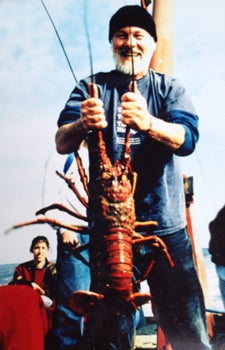In Memoriam: Edwin “Bud” M. Perkins Jr., 75
Edwin “Bud” M. Perkins Jr., a 34-year faculty member in the Department of Biological Sciences at USC Dornsife and an expert in histology, has died. He was 75.
Perkins died of causes related to prostate cancer at his home in Green Valley, Ariz., on Aug. 8, his son Jeff Perkins said.
“My father was extremely generous and kind,” said Perkins of Huntington, Beach, Calif. “He would take time to help out anyone who needed it.”
Bud Perkins was an assistant professor from 1969 to 1974 and associate professor from 1974 to 2003. He retired in 2003 to Arizona where he lived with his ever-present German shepherd, Weiss. Specializing in histology, Perkins focused on skin and aquatic toxicology. He worked in diverse areas from tumorigenesis in fish to the evolution of new world monkeys to the taxonomy and sexual behavior of moths and butterflies.
Perkins was a mainstay of the biological sciences teaching program. He taught what became the department’s first introduction to biology course for majors each Fall in Bovard Auditorium filled with up to 1,000 students. He taught histology, human anatomy and the department’s general education “humans and the environment” course. Perkins also administered the USC teaching internship program, placing students in high school classes throughout Los Angeles.
Donal Manahan, professor of biological sciences and vice dean for students at USC Dornsife, remembered Perkins as a highly popular teacher.
“I know from talking to many former USC students that they have fond memories of their time at USC and the classes they took with Bud [Perkins],” Manahan said.
Doug Capone, William and Julie Wrigley Chair in Environmental Studies and professor and chair of biological sciences, echoed those remarks.

Bud Perkins stands on a research vessel and holds up a huge lobster at the Los Angeles Harbor some 20 years ago. Photo courtesy of Jeff Perkins.
“Bud was an eclectic researcher and highly valued lecturer who was beloved by his undergraduate and graduate students alike,” Capone said. “He was also a dyed-in-the-wool member of the Trojan Family and instilled the Trojan spirit in his children.”
Jeff Perkins, a USC School of Cinematic Arts 2000 alumnus, said his father was a Trojan football “fanatic.” His entire family has been devoted to USC as a result of Bud Perkins’ enthusiasm, he said.
“I came into this world cardinal and gold,” said Jeff Perkins, adding that he will attend the 2013 USC Trojans versus Stanford homecoming game in November in celebration of his father.
The younger Perkins also remembered his father as a great advocate for animals. He recalled how Bud Perkins kept his office window open and a particular blue jay would swoop in each day and land on his desk.
“My dad would feed the blue jay unsalted peanuts,” Perkins recounted. “This went on with the same blue jay for a dozen years. It used to trip students out.”
In the past several years, Bud Perkins became somewhat of a philanthropist, donating to no kill animal shelters and Friends of Madera Canyon, Jeff Perkins said.
Born in Chicago, Bud Perkins was raised in Boston. He earned his bachelor’s in biology at South Dakota State University and his Ph.D. in 1966 from the University of Oregon Medical School.
Jeff Perkins said his father followed the principle of a quote usually attributed to Hunter S. Thompson that he would often repeat and which hung in a frame on his office wall. It read: “Life should not be a journey to the grave with the intention of arriving safely in a pretty and well preserved body, but rather to skid in broadside in a cloud of smoke, thoroughly used up, totally worn out and loudly proclaiming, ‘Wow! What a ride!’ ”
In addition to Jeff Perkins, Bud Perkins is survived by son Chris Perkin of Newbury Park, Calif.
A memorial service will take place Sept. 8 in Arizona. Perkins will be cremated and his ashes scattered across Madera Canyon and the Pacific Ocean.